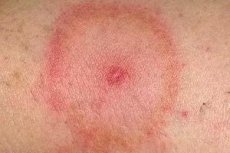Medical expert of the article
New publications
Symptoms of Lyme disease (lyme borreliosis)
Last reviewed: 04.07.2025

All iLive content is medically reviewed or fact checked to ensure as much factual accuracy as possible.
We have strict sourcing guidelines and only link to reputable media sites, academic research institutions and, whenever possible, medically peer reviewed studies. Note that the numbers in parentheses ([1], [2], etc.) are clickable links to these studies.
If you feel that any of our content is inaccurate, out-of-date, or otherwise questionable, please select it and press Ctrl + Enter.

Lyme disease has an incubation period that lasts 5-30 days, most often 10-14 days.
There is no single classification of Lyme disease. The most common classification is clinical.
Clinical classification of Lyme disease
Flow |
Stage |
Severity |
Subclinical |
- |
- |
Spicy |
Early localized infection Early disseminated infection |
Light Moderate severity Heavy |
Chronic |
Remission Exacerbation |
- |
The most common variant is the subclinical course of Lyme disease. The fact of infection is confirmed by an increase in the titer of specific antibodies in paired sera.
The acute course (from several weeks to 6 months) includes two successive stages - early localized infection and early disseminated infection.
The chronic form of the disease can last a lifetime.
Clinical manifestations of Lyme disease at different stages of the infectious process
Damage to organs and systems |
Early localized infection |
Early disseminated infection |
Chronic infection |
General infectious manifestations |
Flu-like syndrome |
Weakness, malaise |
Chronic fatigue syndrome |
Lymphatic system |
Regional lymphadenitis |
Generalized lymphadenopathy |
- |
Leather |
Erythema migrans |
Secondary erythema and exanthema |
Benign lymphocytoma of the skin; chronic atrophic acrodermatitis |
Cardiovascular system |
- |
Atrioventricular block; myocarditis |
- |
Nervous system |
Meningitis: meningoencephalitis, cranial nerve neuritis, radiculoneuritis; Bannwarth syndrome |
Encephalomyelitis; radiculopathy; cerebral vasculitis |
|
Musculoskeletal system |
Myalgia |
Migrating pain in bones, joints, muscles; first attacks of arthritis |
Chronic polyarthritis |
Symptoms of Lyme disease in the early localized infection stage
The onset of the disease is acute or subacute. The first symptoms of Lyme disease are non-specific: fatigue, chills, fever, increased temperature, headache, dizziness, weakness, muscle aches, pain in bones and joints. Catarrhal symptoms (sore throat, dry cough, etc.) often occur against the background of intoxication, which are the cause of diagnostic errors.
The main manifestation of the early localized stage of Lyme disease is erythema migrans at the site of the tick bite. Over the course of several days, the reddened area expands (migrates) in all directions. Other symptoms of Lyme disease in the acute period are variable and transient. Urticarial rash, small transient red dotted and ring-shaped eruptions, and conjunctivitis are possible. One third of patients experience enlarged lymph nodes close to the entry point of infection.
In some patients, erythema is absent, and then the clinical picture only includes fever and general infectious syndrome.
The outcome of stage I may be a complete recovery, the probability of which: increases significantly with adequate antibacterial therapy. Otherwise, even with normalization of temperature and disappearance of erythema, the disease progresses to the stage of disseminated infection.
Symptoms of Lyme disease in the early disseminated infection stage
It develops several weeks or months after the end of the early localized infection stage. Hematogenous spread of infection is most often accompanied by changes in the nervous and cardiovascular systems, skin. Damage to the nervous system usually occurs on the 4th-10th week of the disease and is expressed in the development of neuritis of the cranial nerves. meningitis, radiculoneuritis, lymphocytic meningo-radiculoneuritis (Bannwarth syndrome). Bannwarth syndrome is a variant of neuroborreliosis, common in Western Europe. It is characterized by a sluggish course, pronounced radicular (mainly nocturnal) pain, lymphocytic pleocytosis in the cerebrospinal fluid.
Heart damage in Lyme borreliosis is quite varied: these are conduction disturbances (for example, atrioventricular block - from first degree to complete transverse block), rhythm, myocarditis, pericarditis.
During this period, patients develop transient multiple erythematous rashes on the skin. Less common are mumps, eye lesions (conjunctivitis, iritis, choroiditis, retinitis, panophthalmitis), respiratory organs (pharyngitis, tracheobronchitis), and genitourinary system lesions (orchitis, etc.).
Symptoms of Lyme disease in the chronic infection stage
The chronic course has the following symptoms of Lyme disease - predominant damage to the joints, skin and nervous system.
Typically, patients experience progressive arthralgia, followed by chronic polyarthritis. Most patients experience arthritis relapses over a number of years.
In some cases, chronic infection occurs as benign cutaneous lymphocytoma and chronic atrophic acrodermatitis. Benign cutaneous lymphocytoma is characterized by nodular elements, tumors, or poorly defined infiltrates. Chronic atrophic acrodermatitis is characterized by skin atrophy that develops after a previous inflammatory-infiltrative stage.
In chronic infection, nervous system disorders develop within one to ten years after the onset of the disease. Late nervous system disorders include chronic encephalomyelitis, polyneuropathy, spastic paraparesis, ataxia, chronic axonal radiculopathy, memory disorders, and dementia.
The chronic course of Lyme disease is characterized by alternating periods of remission and exacerbation, after which other organs and systems become involved in the infectious process.


 [
[